Identification of the Pollution Mechanisms and Remediation Strategies for Abandoned Wells in the Karst Areas of Northern China
Abstract
:1. Introduction
2. Materials and Methods
2.1. Study Area
Abandoned Wells
2.2. Research Methodology
2.2.1. Field Investigation and Site Inspection
2.2.2. High-Definition Deep Well Logging Technology (HDWLT)
2.2.3. Analytic Hierarchy Process
- (1)
- Construct a hierarchical structural model. Decompose the complex problem into the objective layer, criteria layer, sub-criteria layer, and assessment layer.
- (2)
- Establish a pairwise comparison matrix. Create a pairwise comparison matrix by comparing the importance of two factors. The 1–9 scale method is generally used (Table 1).
- (3)
- Calculate the consistency rate (CR) [55]. Primarily for the purpose of testing the rationality of the comparison matrix. The calculation formula is as follows:
- (4)
- Weight Calculation. In this work, Python was used to calculate the index weight in the AHP.
- (5)
- Calculate the synthesis score. The comprehensive score for each evaluation object was calculated using the weight and score values of each indicator, based on which an assessment was made. The calculation formula is as follows:
3. Results and Discussion
3.1. Abandoned Well Pollution Risk Assessment
3.1.1. Abandoned Well Pollution Risk Hierarchical Model
- (1)
- Vadose zone media, which determines the infiltration potential of surface water and the vertical migration ability of pollutants, as well as possible chemical reactions that may occur [46,58,59]. Pollutants infiltrating the vadose zone can enter underground through abandoned well channels and cause groundwater pollution.
- (2)
- Abandoned wells penetrate aquifers, and the wellbore penetrates through various geological layers and aquifers. The pollution risk is different for different aquifers. It can also be determined whether the abandoned wells penetrate a single water layer or multiple water layers and whether there is a risk of cross-layer contamination.
- (3)
- Abandoned well depth is an important parameter determining the ability of pollutants to reach specific aquifers [38,60]. Abandoned wells serve as channels communicating pollutants between the source and the groundwater bodies; the deeper the well, the more aquifer layers it communicates with, and the higher the risk of cross-layer contamination.
- (4)
- Pollution sources around the abandoned wells and the environmental surroundings of the abandoned wells have a significant impact on groundwater pollution. Pollutants can enter the ground directly through the channels of abandoned wells, causing groundwater contamination.
- (5)
- Mining pollution: Yangquan City is rich in mineral resources, and pollutants generated during mining, as well as mine pit wastewater formed after mine closure and filled by groundwater, can enter the ground through the channels of abandoned wells, polluting the groundwater environment.
3.1.2. Pairwise Comparison Matrix and Weight Calculation
3.1.3. Abandoned Well Pollution Risk Assessment
3.2. Abandoned Well Pollution Channel and Mechanism
3.2.1. Single-Well Cross-Strata Pollution Channel
- (1)
- Wellhead Channel: The wellhead is the direct pollution channel for abandoned wells [62]. Owing to its exposure to surface conditions, it facilitates the unimpeded entry of pollutants into the subsurface aquifer, thereby compromising groundwater quality. This is a critical pollution channel for abandoned wells.
- (2)
- Well Casing Wall Channel: These channels were formed due to the corrosion and deterioration of the wellbore walls and belong to internal channels. Such channels emerge due to complex interactions between the wellbore and the surrounding geochemical environment, including groundwater chemistry and the chemical properties of adjacent rock formations. The formation of these channels is influenced by factors like the well’s operational lifespan, the quality of wellbore materials, and the chemical properties of the groundwater. The location, number, and size of these channels exhibit significant uncertainty. However, over time, the number of channels increases, and the corrosion pores enlarge, facilitating the ingress of pollutants from the surface or upper aquifers, thereby accelerating the groundwater pollution process.
- (3)
- Annular Space Channel: These channels were formed by the gap between the wellbore wall and the adjacent strata. This is a unique type of pollution channel primarily associated with well-constructed construction techniques and quality. These channels mainly form due to outdated drilling technology that did not include wellbore stabilization, creating an annular space between the wellbore wall and the native rock strata. This space may expand due to improper well use and maintenance, such as excessive water extraction and corrosion of wellbore materials, thereby evolving into significant channels for groundwater pollution. These channels are highly concealed and often overlooked in the general remediation processes for abandoned wells.
3.2.2. Group-Well Cross-Strata Pollution Channel
3.2.3. Abandoned Well Pollution Mechanism
3.3. Abandoned Well Remediation Methodologies
- (1)
- Remediating Annular Space Channel: The specific procedure involves cutting and removing a section of the casing at the location of the bottom aquiclude in the Benxi Formation of the Carboniferous System. Then, a conical wooden plug of a specific diameter is placed at the spot where the casing is removed, serving to block the connection between the upper and lower wellbore. Finally, near the wooden plug, some small holes are cut into the casing through which the cement slurry is injected (Figure 7b).
- (2)
- Remediating the Well Casing Wall Channel: Two methods are employed for the remediation of abandoned wells, contingent upon their post-treatment usability. For wells deemed unusable following remediation, the wellbore is completely sealed using cement slurry (Figure 7c). In contrast, wells assessed as reusable undergo a more nuanced remediation. This involves inserting a new casing, followed by cutting some small holes into the casing around the vicinity of the wooden plug. Then, cement slurry is injected between the old and new casings (Figure 7d). This intervention aims to forestall further corrosion of the original casing. Once remediated in this manner, they can be utilized as potable water sources for local residents or as long-term monitoring wells for governmental oversight.
- (3)
- Wellhead disposals.
4. Conclusions
Supplementary Materials
Author Contributions
Funding
Data Availability Statement
Acknowledgments
Conflicts of Interest
References
- Jia, H.; Qian, H.; Zheng, L.; Feng, W.; Wang, H.; Gao, Y. Alterations to Groundwater Chemistry Due to Modern Water Transfer for Irrigation over Decades. Sci. Total Environ. 2020, 717, 137170. [Google Scholar] [CrossRef] [PubMed]
- Elumalai, V.; Nwabisa, D.P.; Rajmohan, N. Evaluation of High Fluoride Contaminated Fractured Rock Aquifer in South Africa—Geochemical and Chemometric Approaches. Chemosphere 2019, 235, 1–11. [Google Scholar] [CrossRef] [PubMed]
- Bierkens, M.F.P.; Wada, Y. Non-Renewable Groundwater Use and Groundwater Depletion: A Review. Environ. Res. Lett. 2019, 14, 063002. [Google Scholar] [CrossRef]
- Chidambaram, S.; Panda, B.; Keesari, T.; Prasanna, M.V.; Singh, D.K.; Ramanathan, A.L. Isotopic Signatures to Address the Groundwater Recharge in Coastal Aquifers. Mar. Pollut. Bull. 2022, 174, 113273. [Google Scholar] [CrossRef]
- Wei, N.; Guo, B. Deliverable Wellhead Temperature—A Feasibility Study of Converting Abandoned Oil/Gas Wells to Geothermal Energy Wells. Sustainability 2023, 15, 729. [Google Scholar] [CrossRef]
- Shen, H. The Study on Disposal Technology and Management of the Abandoned Well. Master’s Thesis, China University of Geosciences, Beijing, China, 2013. [Google Scholar]
- Cheng, W.-L.; Liu, J.; Nian, Y.-L.; Wang, C.-L. Enhancing Geothermal Power Generation from Abandoned Oil Wells with Thermal Reservoirs. Energy 2016, 109, 537–545. [Google Scholar] [CrossRef]
- Hu, S.; Zhang, A.; Feng, G.; Guo, X.; Miu, X.; Li, C.; Han, D.; Wang, J.; Kang, L. Methane Extraction from Abandoned Mines by Surface Vertical Wells: A Case Study in China. Geofluids 2018, 2018, 8043157. [Google Scholar] [CrossRef]
- Liu, Y.; Ma, G.; Han, Y.; Wang, Y.; Tang, C.; Tian, N.; Tang, X.; Jiang, L.; Zuo, H.; Zhang, Y.; et al. Assessment of the Impact of Abandoned Mine Water on Groundwater Environment. Water 2023, 15, 2649. [Google Scholar] [CrossRef]
- Moghadam, A.; Peters, E.; Nelskamp, S. Gas Leakage from Abandoned Wells: A Case Study for the Groningen Field in the Netherlands. Int. J. Greenh. Gas Control 2023, 126, 103906. [Google Scholar] [CrossRef]
- Townsend-Small, A.; Ferrara, T.W.; Lyon, D.R.; Fries, A.E.; Lamb, B.K. Emissions of Coalbed and Natural Gas Methane from Abandoned Oil and Gas Wells in the United States. Geophys. Res. Lett. 2016, 43, 2283–2290. [Google Scholar] [CrossRef]
- El Hachem, K.; Kang, M. Methane and Hydrogen Sulfide Emissions from Abandoned, Active, and Marginally Producing Oil and Gas Wells in Ontario, Canada. Sci. Total Environ. 2022, 823, 153491. [Google Scholar] [CrossRef] [PubMed]
- Cheng, M.; Fu, X.; Chen, Z.; Liu, T.; Zhang, M.; Kang, J. A New Approach to Evaluate Abandoned Mine Methane Resources Based on the Zoning of the Mining-Disturbed Strata. Energy 2023, 274, 127307. [Google Scholar] [CrossRef]
- Bu, X.; Ma, W.; Li, H. Geothermal Energy Production Utilizing Abandoned Oil and Gas Wells. Renew. Energy 2012, 41, 80–85. [Google Scholar] [CrossRef]
- Santos, L.; Dahi Taleghani, A.; Elsworth, D. Repurposing Abandoned Wells for Geothermal Energy: Current Status and Future Prospects. Renew. Energy 2022, 194, 1288–1302. [Google Scholar] [CrossRef]
- Gass, T.E.; Lehr, J.H.; Heiss, H.W. Impact of Abandoned Wells on Ground Water; Environmental Protection Agency, Office of Research and Development, Robert S. Kerr Environmental Research Laboratory: Washington, DC, USA, 1977. [Google Scholar]
- Avci, C.B. Evaluation of Flow Leakage through Abandoned Wells and Boreholes. Water Resour. Res. 1994, 30, 2565–2578. [Google Scholar] [CrossRef]
- Feng, M. The Study on Groundwater Pollution in Abandon Coal Mine. Master’s Thesis, Liaoning Technical University, Fuxin, China, 2007. [Google Scholar]
- Wang, C. The Numerical Simulation of Abandoned Wells Cementing Technology in Fuyu Oilfield. Master’s Thesis, Northeast Petroleum University, Daqing, China, 2015. [Google Scholar]
- Chen, C. Research on Cementing Technology of Abandoned Wells in Fuyu Oilfiled. Master’s Thesis, Northeast Petroleum University, Daqing, China, 2015. [Google Scholar]
- Jiang, Y. Research and Application of Safe Disposal Technology of Long-Closed Well. Master’s Thesis, Xi’an Shiyou University, Xi’an, China, 2015. [Google Scholar]
- Gao, J. Research and Application of Plugging Technology of Old Wellin Depleted Negative Pressure Gas Storage. Master’s Thesis, China University of Geosciences, Beijing, China, 2021. [Google Scholar]
- Chauveteau, G.; Omari, A.; Tabary, R.; Renard, M.; Veerapen, J.; Rose, J. New Size-Controlled Microgels for Oil Production. In Proceedings of the SPE International Symposium on Oilfield Chemistry, Houston, TX, USA, 13–16 February 2001; pp. 111–118. [Google Scholar]
- Song, X.; Xu, F.; Song, G. Technical Status and Development Suggestions in Exploiting Geothermal Energy from Abandoned Wells. Pet. Drill. Tech. 2020, 48, 1–7. [Google Scholar] [CrossRef]
- Wang, P.; Ma, P.; Liu, J.; Shang, L.; Zhou, Z.; Zhao, W. Research of Processing Technology for Transforming Abandoned Wells into Geothermal Wells. Geol. Explor. 2017, 53, 788–793. [Google Scholar] [CrossRef]
- Liu, X.; Zhao, H.; Han, J. Analysis of Land Use Dynamics in Yangquan. Acta Agric. Jiangxi 2007, 19, 136–138. [Google Scholar]
- Zhang, Y. Research on Karst Groundwater Vulnerability Evaluation of Niangziguan Spring Area. Master’s Thesis, Taiyuan University of Technology, Taiyuan, China, 2020. [Google Scholar]
- Zhang, X. Evolution of Niangziguan Karst Water Systemunder the Impact of Coal Mining Activity. Master’s Thesis, China University of Geosciences, Wuhan, China, 2017. [Google Scholar]
- He, X.; Wu, J.; Guo, W. Karst Spring Protection for the Sustainable and Healthy Living: The Examples of Niangziguan Spring and Shuishentang Spring in Shanxi, China. Expo. Health 2019, 11, 153–165. [Google Scholar] [CrossRef]
- Hao, Y.; Wang, Y.; Zhu, Y.; Lin, Y.; Wen, J.-C.; Yeh, T.-C.J. Response of Karst Springs to Climate Change and Anthropogenic Activities: The Niangziguan Springs, China. Prog. Phys. Geogr. Earth Environ. 2009, 33, 634–649. [Google Scholar] [CrossRef]
- Zhang, J.; Zhu, Z.; Hao, H. The Effects of Climate Variation and Anthropogenic Activity on Karst Spring Discharge Based on the Wavelet Coherence Analysis and the Multivariate Statistical. Sustainability 2023, 15, 8798. [Google Scholar] [CrossRef]
- Gao, Y. Study Onthe Key Technologiesof Digital High-Definition Down-Hole TV Logging System. Master’s Thesis, Xi’an Shiyou University, Xi’an, China, 2015. [Google Scholar]
- Yan, Z.; Luo, Q.; Zheng, X.; Zhang, J. Development and Application of Visual Logging Equipment. In Proceedings of the Springer Series in Geomechanics and Geoengineering; Springer: Berlin/Heidelberg, Germany, 2020; pp. 1807–1815. [Google Scholar]
- Zhao, J. Network High-Definition Downhole TV Video Processing and Ground Control System Development. Master’s Thesis, Xi’an Shiyou University, Xi’an, China, 2018. [Google Scholar]
- Saaty, T.L. The Analytic Hierarchy Process: Planning, Priority Setting, Resource Allocation; McGraw-Hill: New York, NY, USA; London, UK, 1980. [Google Scholar]
- Tavana, M.; Soltanifar, M.; Santos-Arteaga, F.J. Analytical Hierarchy Process: Revolution and Evolution. Ann. Oper. Res. 2021, 326, 879–907. [Google Scholar] [CrossRef]
- Liu, Y.; Eckert, C.M.; Earl, C. A Review of Fuzzy AHP Methods for Decision-Making with Subjective Judgements. Expert Syst. Appl. 2020, 161, 113738. [Google Scholar] [CrossRef]
- Zhao, X.; Wang, D.; Xu, H.; Ding, Z.; Shi, Y.; Lu, Z.; Cheng, Z. Groundwater Pollution Risk Assessment Based on Groundwater Vulnerability and Pollution Load on an Isolated Island. Chemosphere 2022, 289, 133134. [Google Scholar] [CrossRef] [PubMed]
- Saranya, T.; Saravanan, S. Groundwater Potential Zone Mapping Using Analytical Hierarchy Process (AHP) and GIS for Kancheepuram District, Tamilnadu, India. Model. Earth Syst. Environ. 2020, 6, 1105–1122. [Google Scholar] [CrossRef]
- Mukherjee, I.; Singh, U.K. Delineation of Groundwater Potential Zones in a Drought-Prone Semi-Arid Region of East India Using GIS and Analytical Hierarchical Process Techniques. CATENA 2020, 194, 104681. [Google Scholar] [CrossRef]
- Rajkumar, H.; Naik, P.K.; Rishi, M.S. A Comprehensive Water Quality Index Based on Analytical Hierarchy Process. Ecol. Indic. 2022, 145, 109582. [Google Scholar] [CrossRef]
- Sutadian, A.D.; Muttil, N.; Yilmaz, A.G.; Perera, B.J.C. Using the Analytic Hierarchy Process to Identify Parameter Weights for Developing a Water Quality Index. Ecol. Indic. 2017, 75, 220–233. [Google Scholar] [CrossRef]
- Ramanathan, R. A Note on the Use of the Analytic Hierarchy Process for Environmental Impact Assessment. J. Environ. Manag. 2001, 63, 27–35. [Google Scholar] [CrossRef]
- Tesfamariam, S.; Sadiq, R. Risk-Based Environmental Decision-Making Using Fuzzy Analytic Hierarchy Process (F-AHP). Stoch. Environ. Res. Risk Assess. 2006, 21, 35–50. [Google Scholar] [CrossRef]
- Memarbashi, E.; Azadi, H.; Barati, A.A.; Mohajeri, F.; Passel, S.V.; Witlox, F. Land-Use Suitability in Northeast Iran: Application of AHP-GIS Hybrid Model. ISPRS Int. J. Geo-Inf. 2017, 6, 396. [Google Scholar] [CrossRef]
- Allafta, H.; Opp, C.; Patra, S. Identification of Groundwater Potential Zones Using Remote Sensing and GIS Techniques: A Case Study of the Shatt Al-Arab Basin. Remote Sens. 2021, 13, 112. [Google Scholar] [CrossRef]
- Sajil Kumar, P.J.; Elango, L.; Schneider, M. GIS and AHP Based Groundwater Potential Zones Delineation in Chennai River Basin (CRB), India. Sustainability 2022, 14, 1830. [Google Scholar] [CrossRef]
- Khan, M.Y.A.; ElKashouty, M.; Zaidi, F.K.; Egbueri, J.C. Mapping Aquifer Recharge Potential Zones (ARPZ) Using Integrated Geospatial and Analytic Hierarchy Process (AHP) in an Arid Region of Saudi Arabia. Remote Sens. 2023, 15, 2567. [Google Scholar] [CrossRef]
- Tempa, K. District Flood Vulnerability Assessment Using Analytic Hierarchy Process (AHP) with Historical Flood Events in Bhutan. PLoS ONE 2022, 17, e0270467. [Google Scholar] [CrossRef] [PubMed]
- Karan, S.K.; Samadder, S.R.; Singh, V. Groundwater Vulnerability Assessment in Degraded Coal Mining Areas Using the AHP–Modified DRASTIC Model. Land Degrad. Dev. 2018, 29, 2351–2365. [Google Scholar] [CrossRef]
- Mallik, S.; Bhowmik, T.; Mishra, U.; Paul, N. Local Scale Groundwater Vulnerability Assessment with an Improved DRASTIC Model. Nat. Resour. Res. 2021, 30, 2145–2160. [Google Scholar] [CrossRef]
- Shen, L.; Muduli, K.; Barve, A. Developing a Sustainable Development Framework in the Context of Mining Industries: AHP Approach. Resour. Policy 2015, 46, 15–26. [Google Scholar] [CrossRef]
- Mu, E.; Pereyra-Rojas, M. Understanding the Analytic Hierarchy Process. In Practical Decision Making: An Introduction to the Analytic Hierarchy Process (AHP) Using Super Decisions V2; Mu, E., Pereyra-Rojas, M., Eds.; SpringerBriefs in Operations Research; Springer International Publishing: Cham, Switzerland, 2017; pp. 7–22. ISBN 978-3-319-33861-3. [Google Scholar]
- Zhang, Y.; Song, X.; Wang, X.; Jin, Z.; Chen, F. Multi-Level Fuzzy Comprehensive Evaluation for Water Resources Carrying Capacity in Xuzhou City, China. Sustainability 2023, 15, 11369. [Google Scholar] [CrossRef]
- Saaty, T.L. How to Make a Decision: The Analytic Hierarchy Process. Eur. J. Oper. Res. 1990, 48, 9–26. [Google Scholar] [CrossRef]
- Taheri, K.; Missimer, T.M.; Taheri, M.; Moayedi, H.; Mohseni Pour, F. Critical Zone Assessments of an Alluvial Aquifer System Using the Multi-Influencing Factor (MIF) and Analytical Hierarchy Process (AHP) Models in Western Iran. Nat. Resour. Res. 2020, 29, 1163–1191. [Google Scholar] [CrossRef]
- Yan, F. A Study of the Appropriate Zoning for Reasonably Developing of Shallow Geothermal Energy in Hohhot. Ph.D. Thesis, China University of Geosciences, Beijing, China, 2013. [Google Scholar]
- Shaban, A.; Khawlie, M.; Abdallah, C. Use of Remote Sensing and GIS to Determine Recharge Potential Zones: The Case of Occidental Lebanon. Hydrogeol. J. 2006, 14, 433–443. [Google Scholar] [CrossRef]
- Sener, E.; Davraz, A. Assessment of Groundwater Vulnerability Based on a Modified DRASTIC Model, GIS and an Analytic Hierarchy Process (AHP) Method: The Case of Egirdir Lake Basin (Isparta, Turkey). Hydrogeol. J. 2013, 21, 701–714. [Google Scholar] [CrossRef]
- Abu-Bakr, H.A. el-Aziz Groundwater Vulnerability Assessment in Different Types of Aquifers. Agric. Water Manag. 2020, 240, 106275. [Google Scholar] [CrossRef]
- Zhang, X.; Li, X.; Gao, X. Hydrochemistry and Coal Mining Activity Induced Karst Water Quality Degradation in the Niangziguan Karst Water System, China. Environ. Sci. Pollut. Res. 2016, 23, 6286–6299. [Google Scholar] [CrossRef] [PubMed]
- Hoover, J.; Gonzales, M.; Shuey, C.; Barney, Y.; Lewis, J. Elevated Arsenic and Uranium Concentrations in Unregulated Water Sources on the Navajo Nation, USA. Expo. Health 2017, 9, 113–124. [Google Scholar] [CrossRef] [PubMed]
- Huang, H.; Liu, H.; Xiong, S.; Zeng, F.; Bu, J.; Zhang, B.; Liu, W.; Zhou, H.; Qi, S.; Xu, L.; et al. Rapid Transport of Organochlorine Pesticides (OCPs) in Multimedia Environment from Karst Area. Sci. Total Environ. 2021, 775, 145698. [Google Scholar] [CrossRef]
- Lin, J.; Ma, R.; Sun, Z.; Tang, L. Assessing the Connectivity of a Regional Fractured Aquifer Based on a Hydraulic Conductivity Field Reversed by Multi-Well Pumping Tests and Numerical Groundwater Flow Modeling. J. Earth Sci. 2023, XX, 1–14. [Google Scholar] [CrossRef]
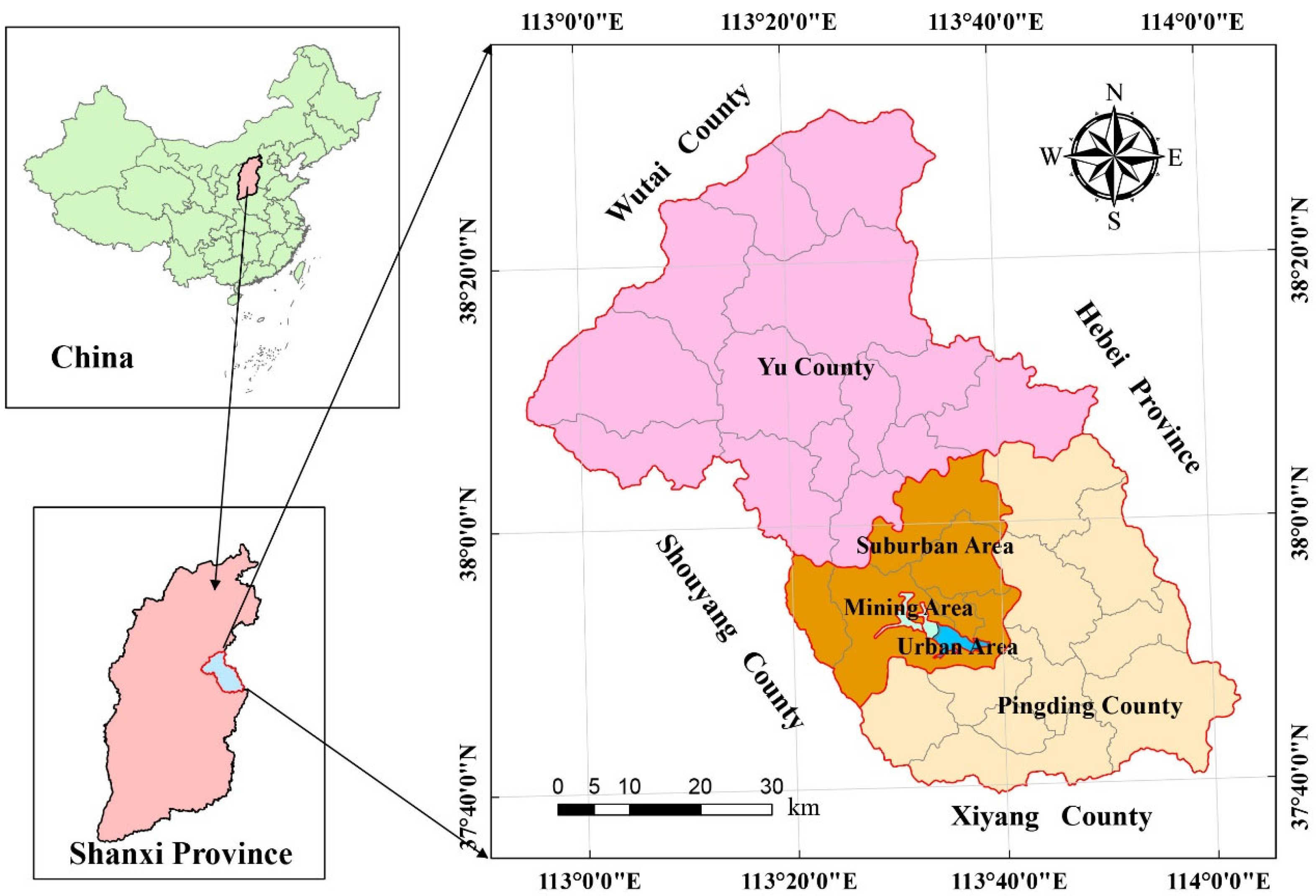
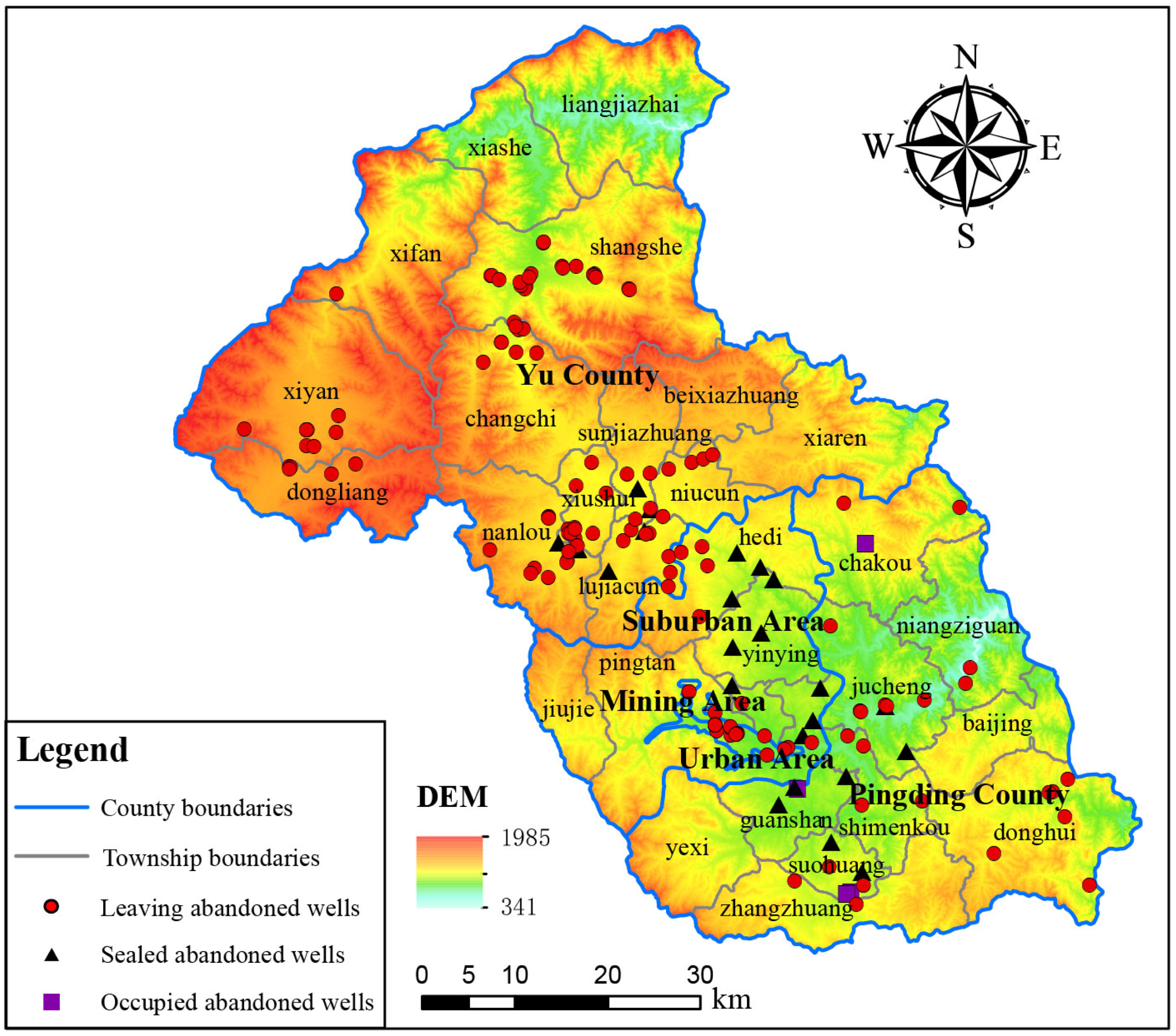
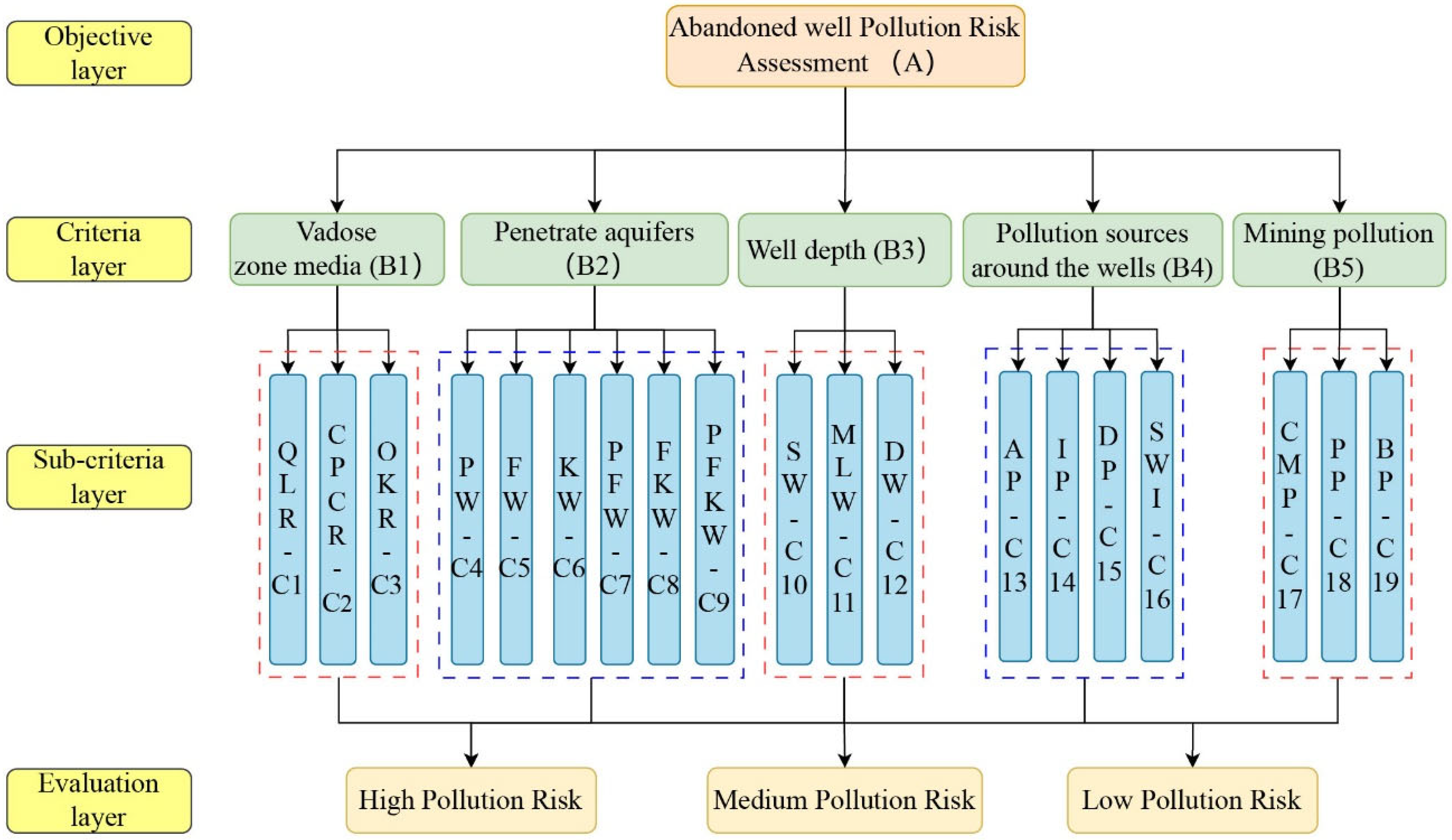
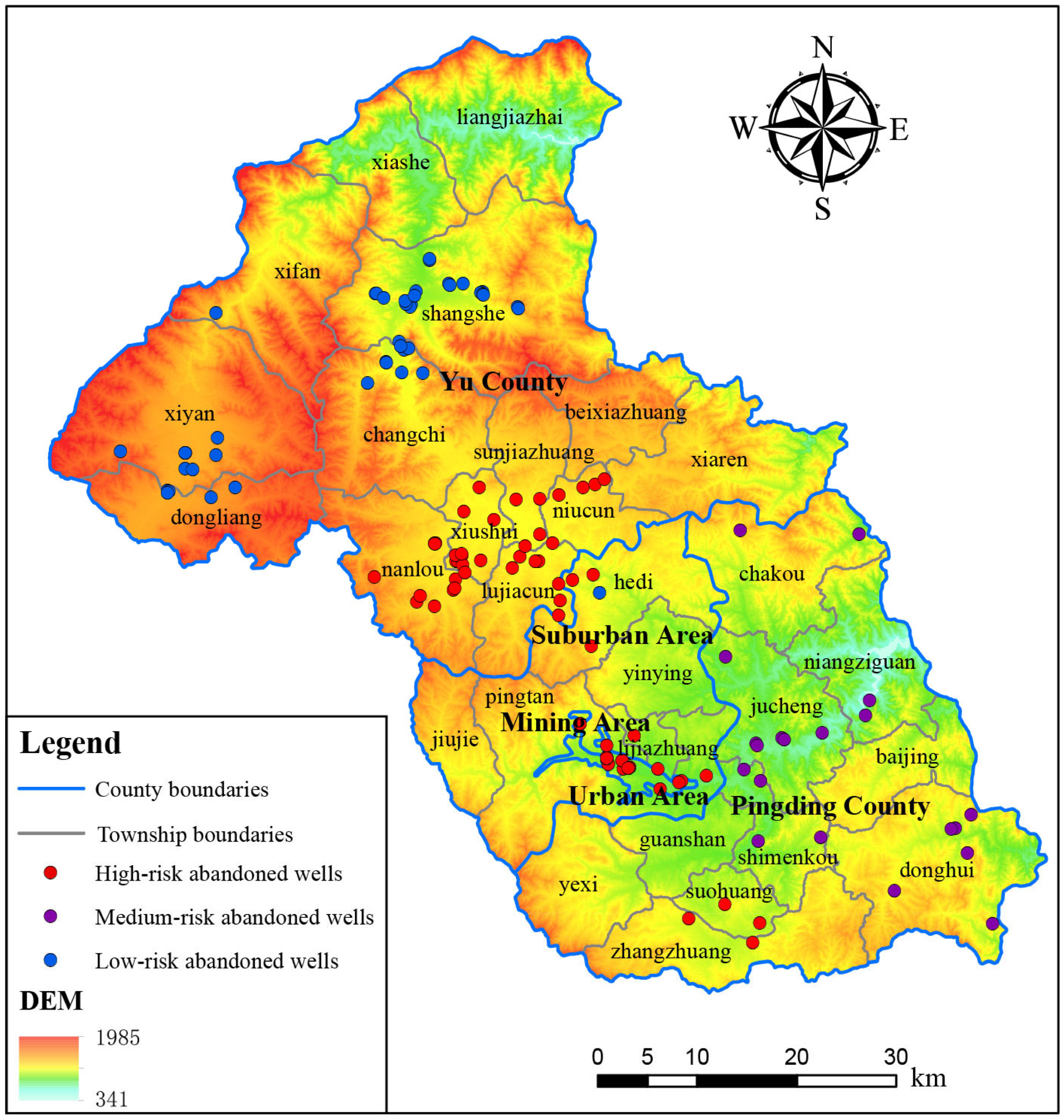
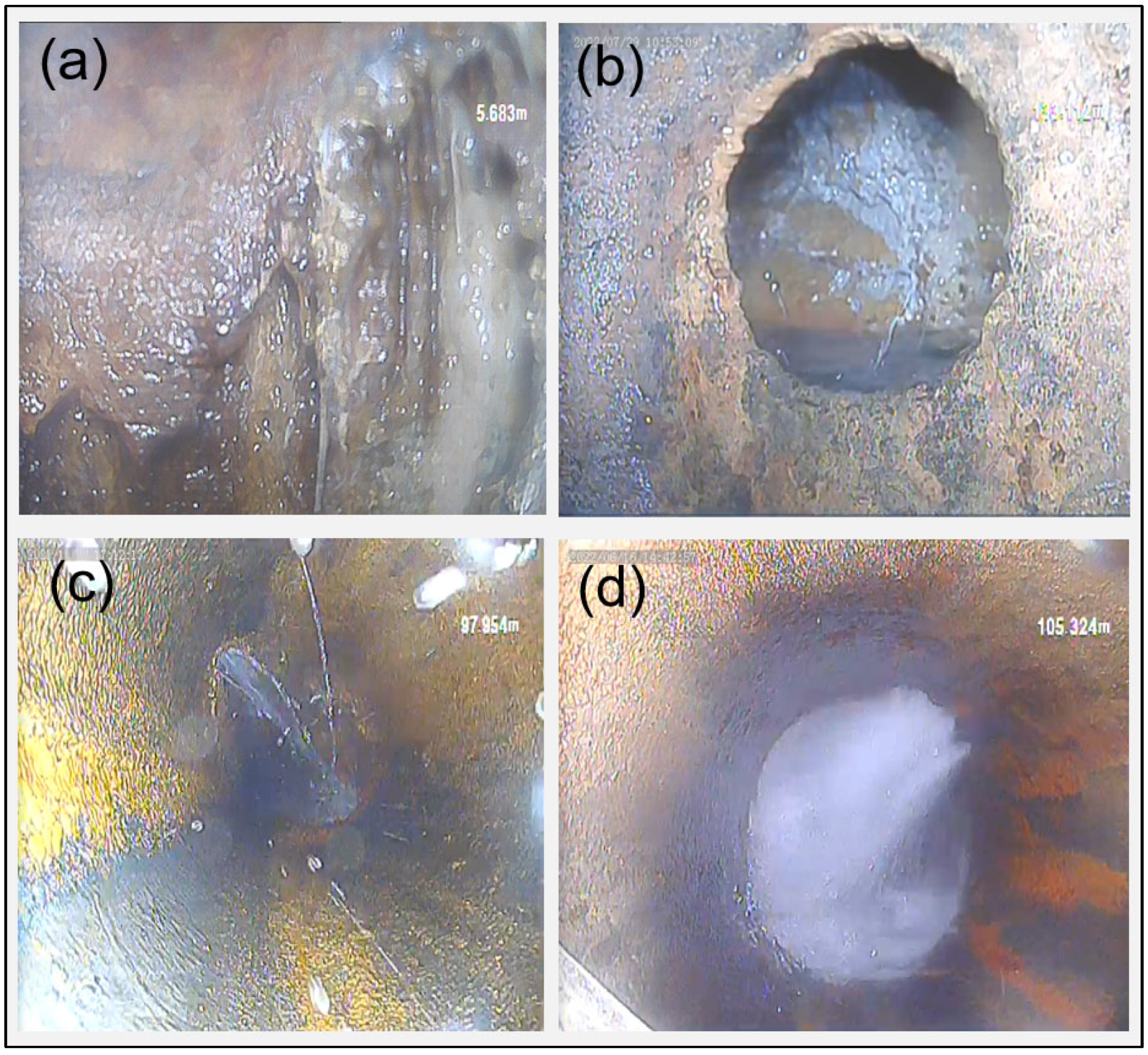
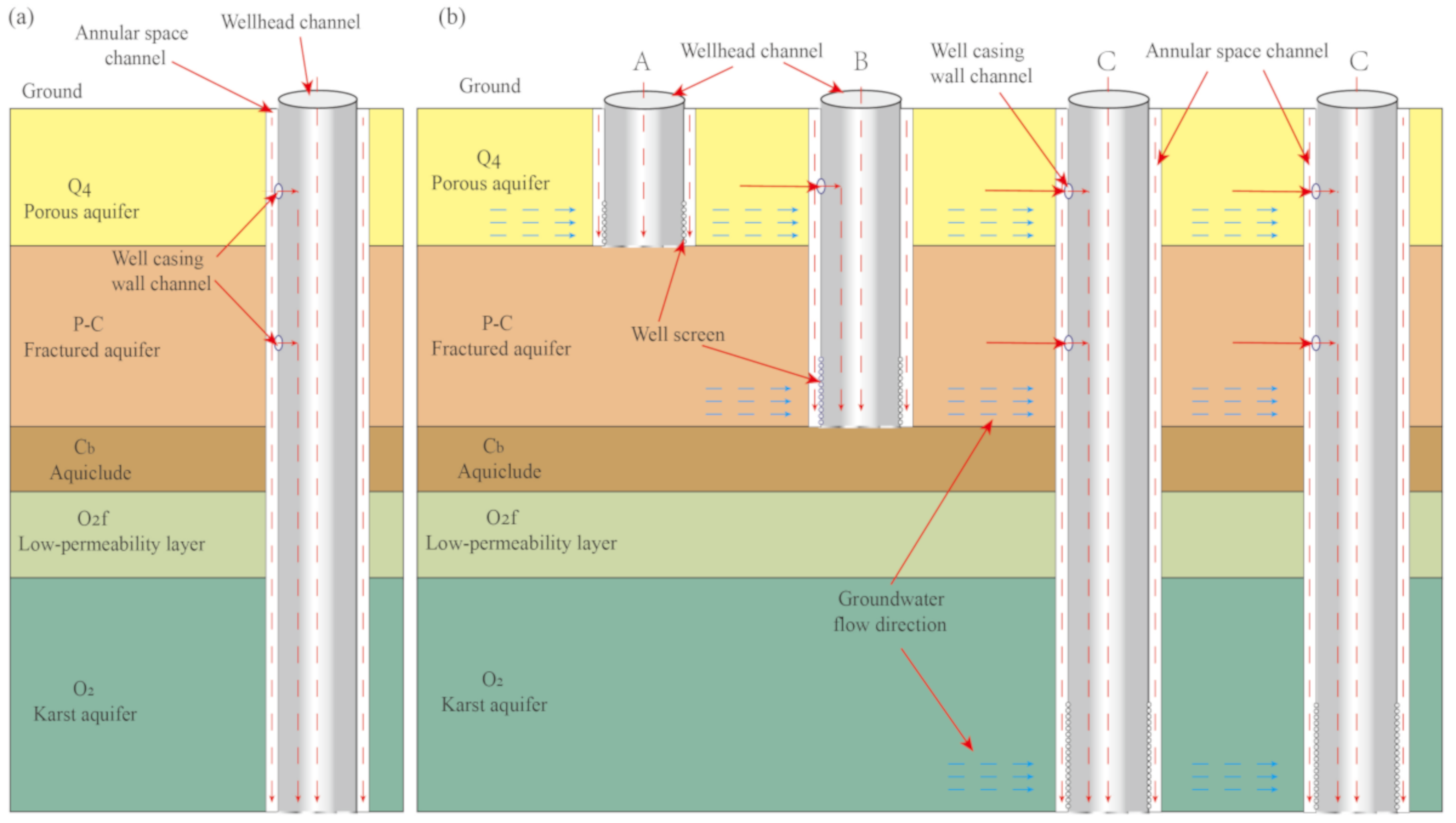
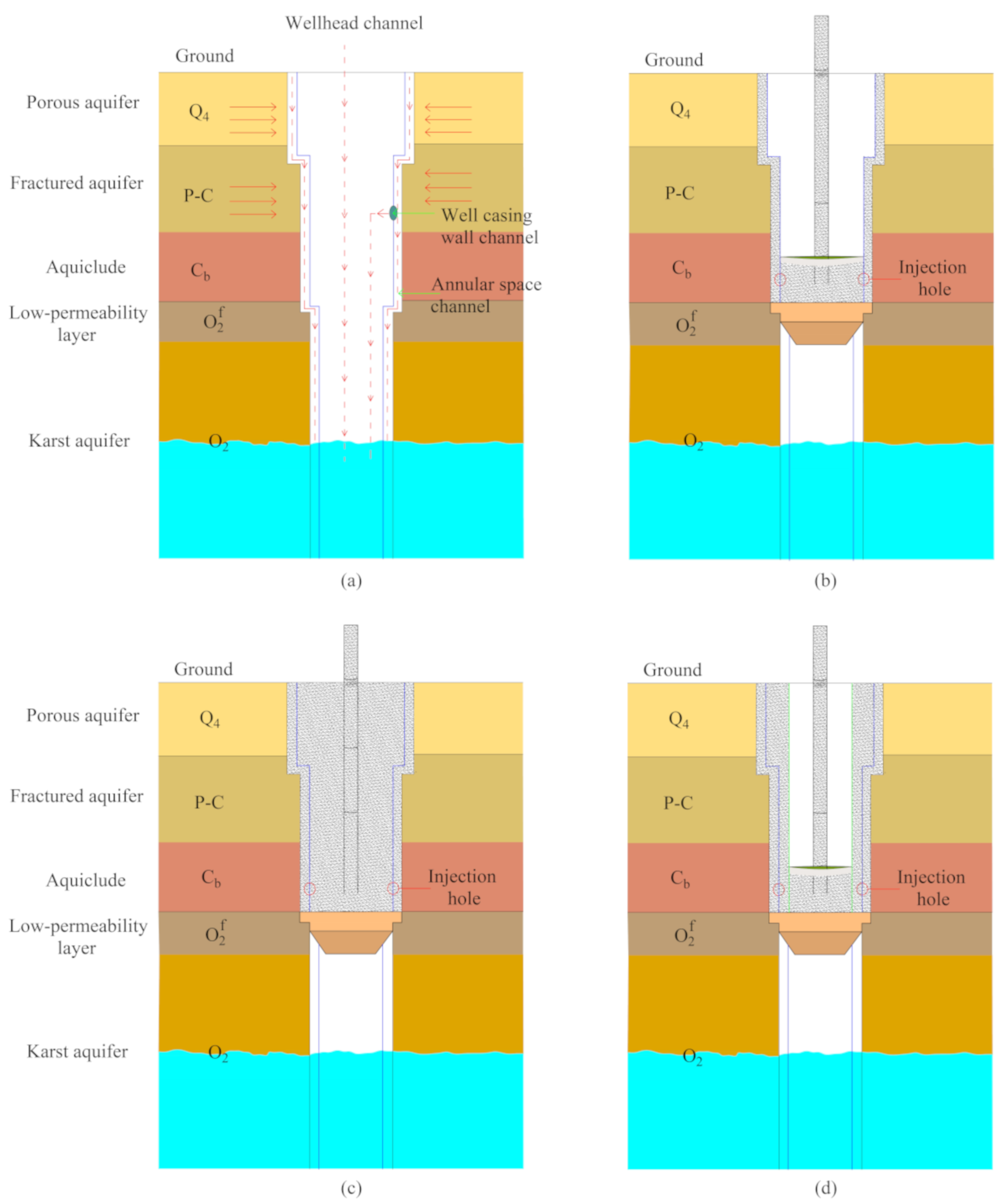
| Relative Importance | Definition |
|---|---|
| 1 | Both factors share equal importance |
| 3 | One factor is slightly more important than the other |
| 5 | One factor is significantly more important than the other |
| 7 | One factor is strongly more important than the other |
| 9 | One factor is extremely more important than the other |
| 2, 4, 6, 8 | Intermediate state between the above two judgments |
| n | 1 | 2 | 3 | 4 | 5 | 6 | 7 | 8 | 9 | 10 | 11 | 12 |
|---|---|---|---|---|---|---|---|---|---|---|---|---|
| RI | 0 | 0 | 0.58 | 0.89 | 1.12 | 1.26 | 1.32 | 1.41 | 1.45 | 1.45 | 1.51 | 1.52 |
| Criteria | B1 | B2 | B3 | B4 | B5 | Weight |
|---|---|---|---|---|---|---|
| B1 | 1 | 1/3 | 1/3 | 1/4 | 1/5 | 0.0594 |
| B2 | 3 | 1 | 1 | 1/2 | 1/3 | 0.1445 |
| B3 | 3 | 1 | 1 | 1/2 | 1/3 | 0.1445 |
| B4 | 4 | 2 | 2 | 1 | 2/3 | 0.2654 |
| B5 | 5 | 3 | 3 | 3/2 | 1 | 0.3862 |
| CR | 0.0095 |
| Sub-Criteria | C1 | C2 | C3 | Weight |
|---|---|---|---|---|
| C1 | 1 | 1/2 | 1/4 | 0.1429 |
| C2 | 2 | 1 | 1/2 | 0.2857 |
| C3 | 4 | 2 | 1 | 0.5714 |
| CR | 0 |
| Sub-Criteria | C4 | C5 | C6 | C7 | C8 | C9 | Weight |
|---|---|---|---|---|---|---|---|
| C4 | 1 | 1/2 | 1/3 | 1/4 | 1/5 | 1/6 | 0.0458 |
| C5 | 2 | 1 | 2/3 | 1/2 | 1/3 | 1/4 | 0.0843 |
| C6 | 3 | 3/2 | 1 | 2/3 | 1/2 | 1/3 | 0.1218 |
| C7 | 4 | 2 | 3/2 | 1 | 2/3 | 1/2 | 0.1720 |
| C8 | 5 | 3 | 2 | 3/2 | 1 | 2/3 | 0.2407 |
| C9 | 6 | 4 | 3 | 2 | 3/2 | 1 | 0.3354 |
| CR | 0.0025 |
| Sub-Criteria | C10 | C11 | C12 | Weight |
|---|---|---|---|---|
| C10 | 1 | 1/2 | 1/5 | 0.1220 |
| C11 | 2 | 1 | 1/3 | 0.2297 |
| C12 | 5 | 3 | 1 | 0.6483 |
| CR | 0.0032 |
| Sub-Criteria | C13 | C14 | C15 | C16 | Weight |
|---|---|---|---|---|---|
| C13 | 1 | 2/3 | 3/2 | 1/3 | 0.1669 |
| C14 | 3/2 | 1 | 2 | 2/3 | 0.2618 |
| C15 | 2/3 | 1/2 | 1 | 1/4 | 0.1180 |
| C16 | 3 | 3/2 | 4 | 1 | 0.4533 |
| CR | 0.0045 |
| Sub-Criteria | C17 | C18 | C19 | Weight |
|---|---|---|---|---|
| C17 | 1 | 2 | 3 | 0.5396 |
| C18 | 1/2 | 1 | 2 | 0.2970 |
| C19 | 1/3 | 1/2 | 1 | 0.1634 |
| CR | 0.0079 |
| Criteria | Weight Bi | Sub-Criteria | Weight Ci | Score Ri |
|---|---|---|---|---|
| B1 | 0.0594 | C1 | 0.1429 | 3 |
| 0.0594 | C2 | 0.2857 | 5.5 | |
| 0.0594 | C3 | 0.5714 | 6.5 | |
| B2 | 0.1445 | C4 | 0.0458 | 3 |
| 0.1445 | C5 | 0.0843 | 5 | |
| 0.1445 | C6 | 0.1218 | 5.5 | |
| 0.1445 | C7 | 0.172 | 6 | |
| 0.1445 | C8 | 0.2407 | 6 | |
| 0.1445 | C9 | 0.3354 | 6.5 | |
| B3 | 0.1445 | C10 | 0.122 | 3 |
| 0.1445 | C11 | 0.2297 | 5.5 | |
| 0.1445 | C12 | 0.6483 | 6.5 | |
| B4 | 0.2654 | C13 | 0.1669 | 6.5 |
| 0.2654 | C14 | 0.2618 | 7 | |
| 0.2654 | C15 | 0.118 | 6 | |
| 0.2654 | C16 | 0.4533 | 8 | |
| B5 | 0.3862 | C17 | 0.5396 | 10 |
| 0.3862 | C18 | 0.297 | 8.5 | |
| 0.3862 | C19 | 0.1634 | 7 |
Disclaimer/Publisher’s Note: The statements, opinions and data contained in all publications are solely those of the individual author(s) and contributor(s) and not of MDPI and/or the editor(s). MDPI and/or the editor(s) disclaim responsibility for any injury to people or property resulting from any ideas, methods, instructions or products referred to in the content. |
© 2023 by the authors. Licensee MDPI, Basel, Switzerland. This article is an open access article distributed under the terms and conditions of the Creative Commons Attribution (CC BY) license (https://creativecommons.org/licenses/by/4.0/).
Share and Cite
Li, H.; Zhang, F.; Du, X.; Tian, D.; Jiao, S.; Zhu, J.; Dai, F. Identification of the Pollution Mechanisms and Remediation Strategies for Abandoned Wells in the Karst Areas of Northern China. Sustainability 2023, 15, 16458. https://doi.org/10.3390/su152316458
Li H, Zhang F, Du X, Tian D, Jiao S, Zhu J, Dai F. Identification of the Pollution Mechanisms and Remediation Strategies for Abandoned Wells in the Karst Areas of Northern China. Sustainability. 2023; 15(23):16458. https://doi.org/10.3390/su152316458
Chicago/Turabian StyleLi, Huayao, Fawang Zhang, Xinqiang Du, Dezhi Tian, Shan Jiao, Jiliang Zhu, and Fenggang Dai. 2023. "Identification of the Pollution Mechanisms and Remediation Strategies for Abandoned Wells in the Karst Areas of Northern China" Sustainability 15, no. 23: 16458. https://doi.org/10.3390/su152316458
APA StyleLi, H., Zhang, F., Du, X., Tian, D., Jiao, S., Zhu, J., & Dai, F. (2023). Identification of the Pollution Mechanisms and Remediation Strategies for Abandoned Wells in the Karst Areas of Northern China. Sustainability, 15(23), 16458. https://doi.org/10.3390/su152316458










